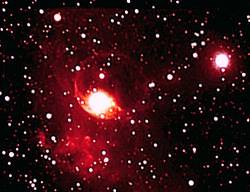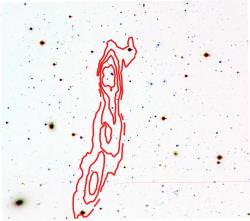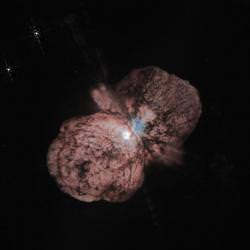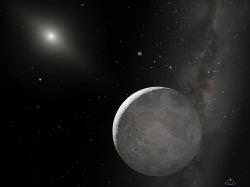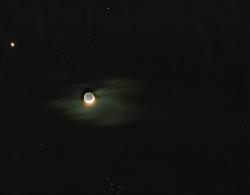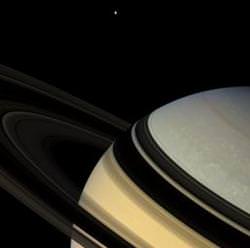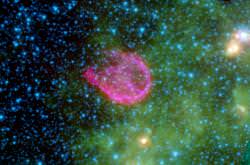An international team of astronomers have conclusive new evidence that a recently discovered “dark galaxy” is, in fact, an object the size of a galaxy, made entirely of dark matter. Although the object, named VIRGOHI21, has been observed since 2000, astronomers have been slowly ruling out every alternative explanation.
In a new research paper, entitled 21-cm synthesis observations of VIRGOHI 21 – a possible dark galaxy in the Virgo Cluster, researchers provide updated evidence about this mysterious galaxy.
They have now performed a high resolution observations of VIRGOHI21 using the Westerbork Synthesis Radio Telescope (WSRT), to better pin down the quantities of neutral hydrogen gas. They also did followup observations with the Hubble Space Telescope, looking for any evidence of stars.
Astronomers first suspected there was an invisible galaxy out there when they spied galaxy NGC 4254. This unusual-looking galaxy appears to be one partner in a cosmic collision. All the normal evidence is there: gas is being siphoned away into a tenuous stream, and one of its spiral arms is being stretched out.
But the other partner in this collision is nowhere to be seen.
The researchers’ calculated that an object with 100 billion solar masses must have careened past NGC 4254 within the last 100 million years, creating the gas stream, and tearing at one of its arms. This was the clue that an invisible dark matter galaxy might be lurking nearby.
A detailed search turned up a mysterious object called VIRGOHI21, located about 50 million light-years from Earth. Were it a normal galaxy, you would be able to see it in a powerful amateur telescope. But there’s nothing there. Even in the Hubble Space Telescope, not a single star is shining from this massive region of space.
It was only visible in radio telescopes, which could detect the radio emissions from neutral hydrogen gas located in the cloud.
When they first published their research a few years ago, the astronomy community was understandably skeptical, and proposed several alternative theories to explain the mysterious object.
For example, there could be additional mass associated with VIRGOHI21, and not just dark matter. The discovery of red giant stars in the region would give some indication that this was a more normal interaction. But Hubble turned up nothing.
Dr. Robert Minchin, lead researcher from the Arecibo Observatory, said, “not even the power of Hubble has been able to see any stars in it.”
It’s possible that VIRGOHI21 has always been this way, formed from primordial dark matter and neutral hydrogen after the Big Bang. It’s been cruising the Universe ever since, disrupting galaxies as it goes.
However, there do seem to be ways that galaxies and their dark matter can be separated. Only a few months ago, a ring of dark matter was found surrounding a group of colliding galaxy clusters by the Hubble Space Telescope. Perhaps VIRGOHI21 is the wreckage from one of these cluster collisions; a shred of dark matter hurled out into space.
It could be that there are many of these dark galaxies out there. A new sky survey, carried out with the 305-metre (1000-foot) Aricebo radio telescope in Puerto Rico should tease out more of these objects in the future. The survey is called the Arecibo Galaxy Environment Survey (AGES).
This most recent paper has been accepted for publication in the Astrophysical Journal.

